
Pultenaea scabra, commonly known as rough bush-pea, is a species of flowering plant in the family Fabaceae and is endemic to south-eastern continental Australia. It is an erect or spreading shrub with hairy stems, heart-shaped leaves with the narrower end towards the base, and yellow and red, pea-like flowers.

Pultenaea daphnoides, commonly known as large-leaf bush-pea or large-leaf bitter-pea, is a species of flowering plant in the family Fabaceae and is endemic to south-eastern Australia. It is an erect shrub with egg-shaped to wedge-shaped leaves with a pointed tip, and dense clusters of bright yellow and red flowers.

Pultenaea muelleri, commonly known as Mueller's bush-pea, is a species of flowering plant in the family Fabaceae and is endemic to Victoria, Australia. It is a dense shrub with hairy stems, elliptic to narrow egg-shaped leaves with the narrower end towards the base, and yellow and red flowers arranged singly or in pairs on the ends of short side shoots.

Pultenaea juniperina, commonly known as prickly bush-pea or prickly beauty is a species of flowering plant in the family Fabaceae and is endemic to south-eastern Australia. It is an erect, spiky shrub with hairy stems, linear to narrow elliptic leaves with stipules at the base, and yellow-orange and red flowers.
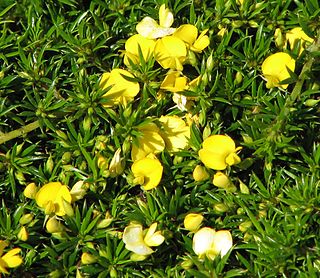
Pultenaea pedunculata, commonly known as matted bush-pea, is a species of flowering plant in the family Fabaceae and is endemic to south-eastern Australia. It is a prostrate, densely matted shrub with softly-hairy branches that often form roots, narrow elliptic leaves, and bright yellow and brick-red flowers.
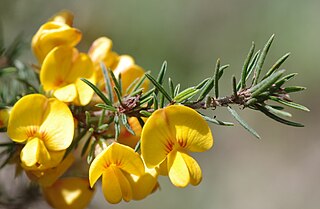
Pultenaea mollis, commonly known as soft bush-pea or guinea flower bush pea, is a species of flowering plant in the family Fabaceae and is endemic to south-eastern Australia. It is an erect or spreading shrub with narrow linear to elliptic or needle-shaped leaves and clusters of up to ten yellow to orange flowers with red markings.

Pultenaea capitellata, commonly known as hard-head bush-pea, is a species of flowering plant in the family Fabaceae and is endemic to south-eastern continental Australia. It is a sprawling to prostrate shrub with elliptic to broadly egg-shaped leaves, and yellow to orange flowers with a red to purple keel.

Pultenaea foliolosa, commonly known as the small-leaf bush-pea, is a species of flowering plant in the family Fabaceae and is endemic to eastern Australia. It is an erect to low-lying shrub with elliptic to oblong leaves that are concave on the upper surface, and yellow to orange and reddish-brown flowers.

Pultenaea hispidula, commonly known as rusty bush-pea, is a species of flowering plant in the family Fabaceae and is endemic to south-eastern continental Australia. It is an erect, spreading shrub with many drooping branches, oblong to egg-shaped leaves with the narrower end towards the base, and yellow to pale orange and red flowers.

Pultenaea largiflorens, commonly known as twiggy bush-pea, is a species of flowering plant in the family Fabaceae and is endemic to south-eastern continental Australia. It is a rigid, erect shrub with narrow egg-shaped leaves with the narrower end towards the base, and bright yellow and crimson flowers.

Pultenaea linophylla, commonly known as halo bush-pea, is a species of flowering plant in the family Fabaceae and is endemic to south-eastern continental Australia. It is an erect or prostrate shrub with spreading branches, linear to elliptic or wedge-shaped leaves, and yellow to orange and red to purple flowers.

Pultenaea luehmannii, commonly known as thready bush-pea, is a species of flowering plant in the family Fabaceae and is endemic to the Grampians National Park. It is a diffuse, more or less prostrate sub-shrub with trailing branches, narrow elliptic leaves, and orange and dark brown flowers.

Pultenaea parviflora, sommonly known as Sydney bush-pea, is a species of flowering plant in the family Fabaceae and is endemic to eastern New South Wales. It is usually a small, erect shrub with wedge-shaped to narrow egg-shaped leaves with the narrower end towards the base, and clusters of yellow to orange and red flowers.

Pultenaea penna, commonly known as feather bush-pea, is a species of flowering plant in the family Fabaceae and is endemic to south-eastern continental Australia. It is a rigid, spreading shrub with linear, needle-shaped leaves and yellow and red, pea-like flowers.

Pultenaea polifolia, commonly known as dusky bush-pea, is a species of flowering plant in the family Fabaceae and is endemic to south-eastern continental Australia. It is an erect to prostrate shrub with linear or elliptic to egg-shaped leaves with the narrower end towards the base, and yellow to orange and red to purple flowers.
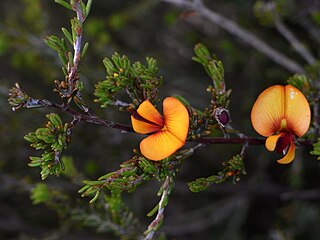
Pultenaea prostrata, commonly known as silky bush-pea, is a species of flowering plant in the family Fabaceae and is endemic to south-eastern Australia. It is a small, rigid, wiry, low-lying or prostrate shrub with cylindrical leaves, and yellow, red and purple-brown flowers.

Pultenaea reflexifolia, commonly known as wombat bush-pea, is a species of flowering plant in the family Fabaceae and is endemic to isolated parts of Victoria. It is an erect shrub with its foliage covered with tangled hairs, and has elliptic to narrow egg-shaped leaves with the narrower end towards the base, and yellow and red pea-like flowers arranged singly or in pairs on the ends of short side branches.
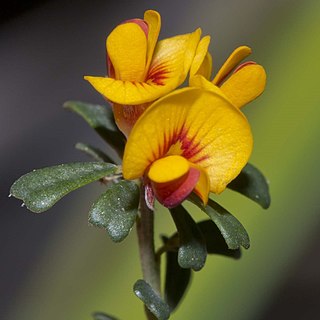
Pultenaea retusa, commonly known as notched bush-pea, is a species of flowering plant in the family Fabaceae and is endemic to eastern continental Australia. It is an erect shrub with wedge-shaped or egg-shaped leaves with the narrower end towards the base, and yellow to orange and red to purple flowers.
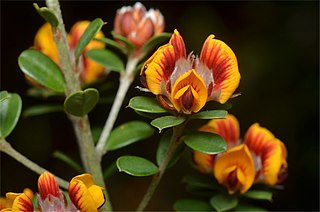
Pultenaea stricta, commonly known as rigid bush-pea, is a species of flowering plant in the family Fabaceae and is endemic to south-eastern continental Australia. It is a slender, erect or low-lying shrub with elliptic to egg-shaped leaves with the narrower end towards the base, and yellow and red, pea-like flowers.

Pultenaea vrolandii, commonly known as cupped bush-pea, is a species of flowering plant in the family Fabaceae and is endemic to south-eastern continental Australia. It is an erect shrub with hairy, arching branchlets, elliptic to egg-shaped leaves, and yellow to orange and red to brown flowers.




















